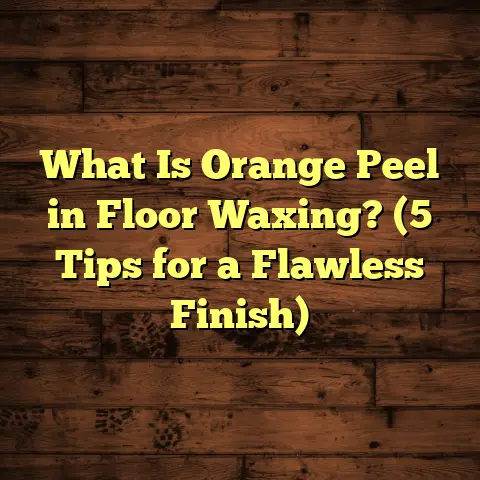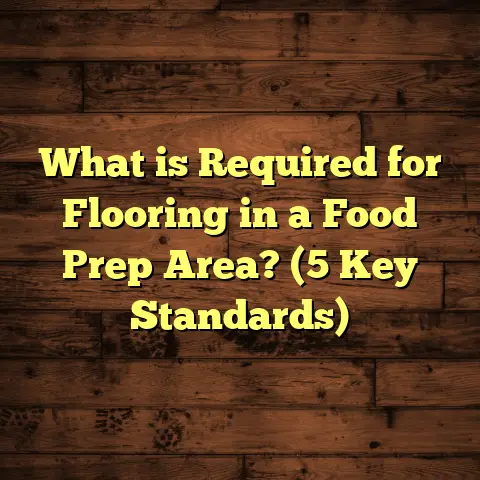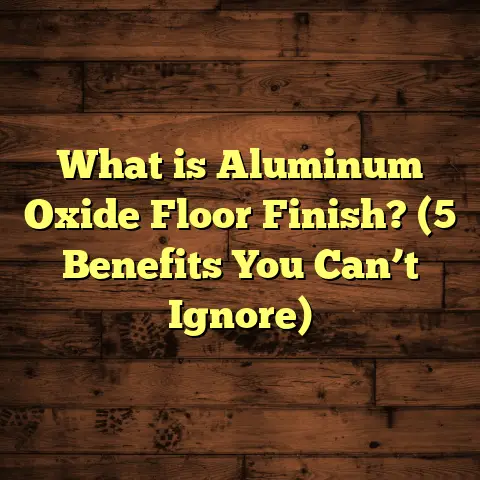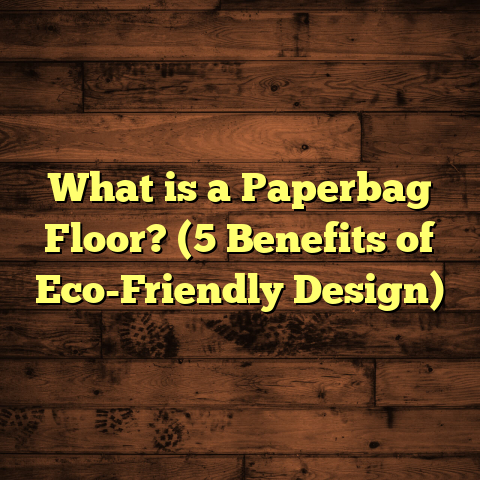What is the Widest Vinyl Floor Covering? (5 Key Features Revealed)
Did you know that vinyl flooring accounts for about 30% of the residential flooring market in the U.S.? That’s huge! Vinyl floors have become incredibly popular because they’re versatile, durable, and affordable. But when clients ask me, “What is the widest vinyl floor covering available?” I realize this question opens up a lot more than just dimensions. It touches on the manufacturing, design choices, installation challenges, and practical benefits too. So, let’s get into it.
What Is the Widest Vinyl Floor Covering?
Simply put, the widest vinyl floor covering refers to vinyl flooring products that come in the broadest width per plank or sheet. Vinyl flooring typically comes in two main formats:
- Vinyl planks or tiles — These mimic hardwood or stone and are usually narrower.
- Vinyl sheets — These come in very wide rolls and cover larger areas without seams.
The “width” here means the actual physical width of either the plank or the sheet that you lay down. Most vinyl planks range from 6 inches to 9 inches wide. However, vinyl sheets can come in widths exceeding 12 feet (144 inches), which is massive in comparison.
Why Does Width Matter?
You might wonder, why does width even matter? Wider vinyl sheets mean fewer seams and a smoother, more continuous appearance. This can really impact the look and feel of a room, especially larger spaces like commercial lobbies or open-concept living areas.
I remember working on a client’s modern loft where we used 12-foot-wide luxury vinyl sheets. The seamless look wowed everyone and made maintenance easier because there were fewer edges to trap dirt or peel.
Understanding Vinyl Flooring Types and Their Widths
Before diving deeper into the widest options, it’s helpful to understand the different kinds of vinyl flooring and their typical dimensions.
Vinyl Plank Flooring
Vinyl plank flooring (also called luxury vinyl plank or LVP) is designed to replicate wood floors closely. Most planks are manufactured in widths ranging from 6 to 9 inches, with lengths between 36 and 72 inches.
Why these sizes? The goal is to mimic natural hardwood sizes for an authentic look. Narrower planks tend to be easier to handle and install, but they create more seams.
In my experience installing vinyl planks in numerous homes, the narrower widths allow for intricate patterns like herringbone or diagonal layouts. But if you want fewer seams, wider planks are better — though they are less common.
Vinyl Sheet Flooring
Vinyl sheet flooring is sold in large rolls that can be anywhere from 6 feet wide to over 12 feet wide. These sheets come in lengths up to 100 feet or more.
This format is especially popular in commercial environments like hospitals, schools, and retail stores because:
- It creates near-seamless flooring.
- It’s quicker to install over large areas.
- It resists water infiltration better than planks due to fewer seams.
Residential use of sheet vinyl has declined somewhat due to the rise of LVP but remains excellent for wet areas like bathrooms and basements.
Manufacturing Wide Vinyl Sheets: How Are They Made?
Getting a wide vinyl sheet isn’t just about rolling out more material — there’s serious engineering behind it.
Raw Materials and Construction Layers
Vinyl flooring is primarily made from polyvinyl chloride (PVC) resin mixed with plasticizers that give it flexibility. Other ingredients include stabilizers, pigments for color, and additives for UV resistance.
The typical vinyl sheet has several layers:
- Backing Layer: Usually fiberglass or felt that gives dimensional stability and prevents stretching.
- Core Layer: PVC resin mixed with plasticizers forms the bulk of the sheet.
- Printed Design Layer: High-resolution digital prints imitate wood grain, stone veining, or tile patterns.
- Protective Wear Layer: A transparent urethane coating that protects against scratches, stains, and wear.
Calendaring Process for Wide Sheets
Wide vinyl sheets are produced using a calendaring machine — a series of rollers that flatten heated vinyl into thin sheets of precise thickness.
For wider sheets (up to 12 feet or more), manufacturers use special wide rollers and controlled environments to maintain uniform thickness. Temperature control is critical: too hot can cause warping; too cold leads to brittleness.
I visited a factory once where operators explained how they constantly monitor sheet thickness down to microns using laser sensors during production. This ensures the sheet doesn’t have weak spots that could tear during installation.
Printing Techniques
High-definition printing technology allows manufacturers to create realistic patterns over large widths without visible repetition or pixelation.
Modern printers use multiple passes with different ink layers:
- Base colors
- Textures
- Highlights and shadows
This layered printing creates depth that mimics natural materials very well.
Coating Application
After printing, the wear layer is applied — often via UV curing which hardens urethane quickly under ultraviolet light without heating the sheet excessively.
This step ensures long-lasting protection while keeping the surface flexible enough for installation.
My Experience With Wide Vinyl Sheets on Large Projects
One project stands out vividly: a 5,000-square-foot office lobby where we installed 12-foot-wide commercial vinyl sheets. The client wanted a smooth marble-like appearance without grout lines or mosaic tiles breaking up the flow.
Using wide rolls sped installation up significantly — instead of fitting dozens of smaller pieces, we rolled out just a few large sheets. Handling such wide material was tricky; it required four installers at once to avoid creases or damage during placement.
But the payoff was worth it:
- The lobby looked sleek and modern.
- Maintenance staff reported easier cleaning with no grout lines.
- The client saved on labor costs due to quicker installation.
From that experience, I realized how wide vinyl sheets combine aesthetics with practicality exceptionally well.
Five Key Features of the Widest Vinyl Floor Covering
Now that we’ve covered what these wide vinyl sheets are and how they’re made, here’s what really sets them apart based on my hands-on knowledge:
1. Seamless Visual Appeal
Wide sheets drastically reduce seams compared to planks or narrow rolls. Fewer seams mean:
- A cleaner look
- Less opportunity for dirt buildup
- Better resistance to water penetration
Seams often become focal points if not aligned perfectly, so reducing their number improves overall floor uniformity.
I once had a homeowner complain about seams in their vinyl planks looking “like cracks.” Switching them to wide sheet vinyl was a game changer for their satisfaction.
2. Superior Water Resistance
Because seams are minimized, wide vinyl sheets are ideal in moisture-prone areas such as:
- Bathrooms
- Kitchens
- Laundry rooms
- Basements
Water infiltration often happens at seams in narrower products. Wide sheets with waterproof welds create nearly waterproof surfaces.
A hospital client I worked with specified wide sheet vinyl precisely for infection control — seamless floors are easier to sanitize thoroughly.
3. Enhanced Durability
Wide vinyl sheets often come with thicker wear layers than narrow planks because commercial-grade sheets need extra protection against heavy foot traffic.
For example:
| Use Case | Typical Wear Layer Thickness |
|---|---|
| Residential | 6–12 mils (0.15–0.3 mm) |
| Commercial Light | 12–20 mils (0.3–0.5 mm) |
| Heavy Commercial | Up to 28 mils (0.7 mm) |
Thicker wear layers resist scratches from furniture, heels, and pet claws better over time.
4. Installation Speed
Since fewer pieces need cutting and fitting, installers save a lot of time laying wide sheets — especially over large open spaces.
However, handling large rolls demands skill and teamwork to prevent wrinkles or folds during placement.
I often schedule multiple installers for wide-sheet jobs just to ensure smooth handling.
5. Waste Reduction
Fewer seams mean less cutting waste overall.
By measuring room dimensions precisely using tools like FloorTally, I can order just enough material accounting for waste factors — typically around 5-7% extra depending on room shape complexity.
FloorTally has been invaluable here because it calculates cut layouts based on roll width automatically, avoiding over-ordering expensive materials.
Digging Deeper: Technical Specs That Matter When Choosing Wide Vinyl Sheets
When selecting wide vinyl flooring products for your project, pay attention to these specs:
Roll Width Options
Most common widths include:
- 6 feet (72 inches)
- 9 feet (108 inches)
- 12 feet (144 inches)
- Specialty commercial rolls up to 15 feet (180 inches)
The wider the roll you choose, the fewer seams you’ll have but also higher upfront cost and installation complexity.
Thickness
Total thickness varies from about 2mm up to 5mm or more in heavy-duty commercial applications.
- Thicker floors feel more cushioned underfoot.
- They typically offer better sound insulation.
- Thicker floors tolerate subfloor imperfections better without telegraphing bumps through surface.
Wear Layer Thickness
Wear layer thickness determines durability:
- Less than 6 mils: Not recommended for heavy use.
- 6–12 mils: Suitable for most residential applications.
- 12–20 mils: Commercial light-to-medium traffic.
- Above 20 mils: Heavy commercial environments like airports or hospitals.
Backing Material
Backing affects stability and comfort:
- Felt backing offers sound absorption but less moisture resistance.
- Fiberglass backing provides dimensional stability.
- Cork backing adds soundproofing and eco-friendliness but may cost more.
Installation Method
Wide vinyl sheets usually require:
- Full-spread adhesive application.
- Heat welding seams for waterproofing.
- Professional cutting tools for clean edges.
Some products offer loose-lay or click-lock systems but these are rare in very wide formats due to weight and flexibility factors.
Case Studies That Highlight Advantages of Wide Vinyl Flooring
Case Study #1: Retail Store Renovation
A retail chain wanted an easy-to-clean floor that looked upscale but was budget-friendly across multiple locations averaging 3,000 sq ft each.
We recommended 12-foot-wide commercial vinyl sheets with a 20-mil wear layer printed in a polished concrete design.
Results:
- Installation time cut by nearly 40% compared to previous tile floors.
- Maintenance staff reported easier cleaning with no grout lines.
- Customers complimented the modern sleek look matching store branding.
This project showed how wider sheets improve business efficiency beyond aesthetics.
Case Study #2: Luxury Condo Bathroom Remodel
In one condo bathroom renovation, we replaced old tile with a wide vinyl sheet featuring marble pattern print in a 9-foot roll width.
The client loved how the seamless pattern mimicked natural stone without grout maintenance hassles.
Key Takeaway: The wide sheet allowed large-format patterns without visual breaks — impossible with smaller planks or tiles in tight spaces like bathrooms.
Case Study #3: Hospital Flooring Upgrade
Hospitals demand hygienic floors resistant to chemicals and wear.
Using wide commercial vinyl sheets allowed us to minimize seams where pathogens usually collect while installing thick wear layers suited for heavy foot traffic and wheeled equipment.
Outcome:
- Improved infection control protocols.
- Reduced slip hazards due to continuous surface.
- Long-term cost savings on cleaning and repairs.
Practical Tips for Choosing and Installing Wide Vinyl Floor Coverings
If you’re considering going wide with your next flooring project, here’s some advice from my years on the job:
Measure Twice, Order Once
Accurate measurements are critical because mistakes get costly when ordering large rolls that can’t be easily returned. Use digital tools like FloorTally or laser distance meters for precision.
Consider Subfloor Condition
Wide sheets highlight subfloor imperfections more than narrower planks because there’s less chance for seams to disguise bumps or dips. Make sure your subfloor is level within ±1/8 inch over 6 feet for best results.
Plan Installation Logistics
Handling huge rolls requires space and manpower. Clear furniture out well ahead and ensure you have at least two people per roll during installation to avoid damage or wrinkles.
Think About Maintenance
Wide sheet vinyl floors clean easily but still benefit from regular sweeping and damp mopping with recommended cleaners. Avoid harsh chemicals that can degrade the wear layer prematurely.
How FloorTally Helps Me Manage Flooring Projects Efficiently
Over the years, as projects grew larger and more complex, I found myself juggling multiple quotes for materials, labor costs, waste estimates — it became overwhelming quickly!
FloorTally changed the game because it lets me input room dimensions along with preferred material types and roll widths. It then calculates:
- Total material needed including waste factors
- Estimated labor time based on local rates
- Overall project cost breakdown by product type
This tool keeps my proposals accurate and helps clients understand where their money is going upfront — no surprises later!
Frequently Asked Questions About Wide Vinyl Flooring
Q: Can I install wide vinyl sheets myself?
A: It’s possible but challenging due to size and adhesive application requirements. Professionals have special tools and experience to avoid wrinkles or bubbles during installation.
Q: Are wider vinyl floors more expensive?
A: Generally yes per linear foot because of manufacturing complexity and thicker wear layers but savings on labor can offset this in large projects.
Q: What maintenance do wide vinyl floors need?
A: Regular sweeping/damp mopping with mild cleaners keeps floors looking great. Avoid abrasive scrubbers or harsh chemicals that can damage wear layers.
Q: Can I install wide vinyl over existing flooring?
A: In some cases yes if subfloor is smooth/level but often removal of old flooring is recommended to ensure adhesion and longevity.
Final Thoughts From My Flooring Journey
When clients ask me about the widest vinyl floor covering available nowadays I tell them it’s those massive luxury vinyl sheets rolling out at widths up to 12 feet or more in commercial lines — sometimes even wider in specialty applications!
They combine beauty with practicality by offering seamless looks, superior durability, ease of maintenance, and efficient installation for big spaces. But they also require careful planning around measurements, handling logistics, subfloor prep, and professional installation techniques — all things I’ve learned through many projects firsthand.
Whether you’re remodeling your bathroom or outfitting a commercial lobby, considering these wide formats might just be what your space needs for that perfect mix of style and function.
Got questions about your own flooring plans? Feel free to ask — I’m always happy to share what works best based on years of hands-on experience!





